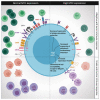Impact of MYC on Anti-Tumor Immune Responses in Aggressive B Cell Non-Hodgkin Lymphomas: Consequences for Cancer Immunotherapy
- PMID: 33092116
- PMCID: PMC7589056
- DOI: 10.3390/cancers12103052
Impact of MYC on Anti-Tumor Immune Responses in Aggressive B Cell Non-Hodgkin Lymphomas: Consequences for Cancer Immunotherapy
Abstract
Patients with MYC overexpressing high grade B cell lymphoma (HGBL) face significant dismal prognosis after treatment with standard immunochemotherapy regimens. Recent preclinical studies indicate that MYC not only contributes to tumorigenesis by its effects on cell proliferation and differentiation, but also plays an important role in promoting escape from anti-tumor immune responses. This is of specific interest, since reversing tumor immune inhibition with immunotherapy has shown promising results in the treatment of both solid tumors and hematological malignancies. In this review, we outline the current understanding of impaired immune responses in B cell lymphoid malignancies with MYC overexpression, with a particular emphasis on diffuse large B cell lymphoma. We also discuss clinical consequences of MYC overexpression in the treatment of HGBL with novel immunotherapeutic agents and potential future treatment strategies.
Keywords: MYC; MYC inhibition; T cell therapy; diffuse large B cell lymphoma; high grade B cell lymphoma; immunotherapy; tumor immune evasion.
Conflict of interest statement
Authors declare no conflict of interest; A.V.d.J. and M.G.M.R. have nothing to disclose. T.M. received research support from Janssen Pharmaceuticals, Novartis, Celgene, Bristol-Myers Squibb, Amgen, Aduro and Onkimmune; B.S. received research funding from Dutch Cancer Society (KWF Kankerbestrijding, grant 11137); M.E.D.C. received research funding from BMS, Celgene, Gilead and GenMab.
Figures



References
-
- Swerdlow S.H., Campo E., Pileri S.A., Harris N.L., Stein H., Siebert R., Advani R., Ghielmini M., Salles G.A., Zelenetz A.D., et al. The 2016 revision of the World Health Organization classification of lymphoid neoplasms. Blood. 2016;127:2375–2390. doi: 10.1182/blood-2016-01-643569. - DOI - PMC - PubMed
-
- Cerhan J.R. In: Aggressive Lymphomas. Lenz G., Salles G., editors. Springer; München, Germany: 2019.
-
- Horn H., Ziepert M., Becher C., Barth T.F., Bernd H.W., Feller A.C., Klapper W., Hummel M., Stein H., Hansmann M.L., et al. MYC status in concert with BCL2 and BCL6 expression predicts outcome in diffuse large B-cell lymphoma. Blood. 2013;121:2253–2263. doi: 10.1182/blood-2012-06-435842. - DOI - PubMed
Publication types
LinkOut - more resources
Full Text Sources

